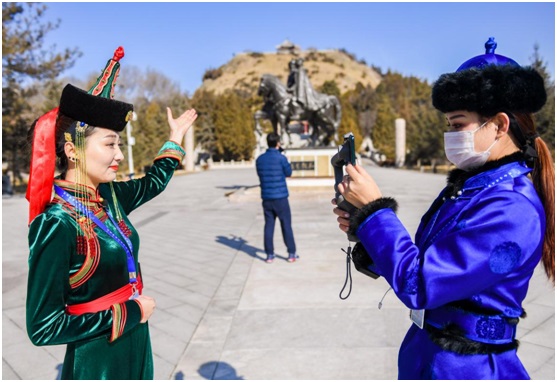By Kong Dechen, People’s Daily Overseas Edition
5G technology is changing the lifestyles of the Chinese and reshaping global consumption and production with faster network, better user experience and more convenient services.
The technology enabled medical experts from around the country to carry out teleconsultations and check patients’ conditions when China was hit by COVID-19. It also powers online education and telecommuting platforms where students and employees study and work from home.
Zhang Shuihan is a fancier of digital products from Beijing who bought a Huawei 5G cell phone online earlier this month. “The future will be powered by 5G,” she said, adding that “the earlier I buy it, the earlier I can enjoy it. Though the network covers not much now, I believe 5G smart phones will become the majority.
China had over 130,000 5G base stations as of the end of last year, according to the Ministry of Industry and Information Technology (MIIT). In January 2020, the country’s cell phone shipments reached 20.813 million units, including 5.465 million 5G models. The country’s homemade chips for 5G smart phones were also commercialized, with remarkable progress achieved in 5G application.
Chinese telecom giant China Mobile has kicked off its second 5G procurement plan and the company has at least built 80,000 5G base stations and contracted 10 million registered users for 5G network. Though impacted by COVID-19, the company still maintains its annual target this year – to expand the number of base stations across China to 300,000 and cover all prefecture-level cities and above with 5G network.
Liu Xiangdong, deputy director of the economic research department at the China Center for International Economic Exchanges, said 5G features low latency and a stronger broadband connection compared with 4G, and its convenience is the major reason for consumers to replace their smartphones.
“With wider deployment of 5G base stations and improving infrastructure, most consumers will consider 5G smartphones if the 5G packages don’t cost much more,” Liu said, adding that this will push consumers to upgrade to 5G at a faster speed.
5G technology significantly improved the efficiency of online education and telecommuting as Chinese employees worked from home with telecommuting applications and students had courses at home on livestreaming platforms to avoid cross-infection during the COVID-19 epidemic.
Telecommuting, video conferencing and remote education call for immersive experience, said Liu, explaining that augmented reality (AR) or virtual reality (VR) might be applied to such services, which requires strong stability and connection for network transmission, and 5G technology can offer more than what’s needed.
The forefront technology also played a big role in teleconsultation, remote command and video conferencing during the nationwide fight against the novel coronavirus epidemic. At Leishenshan Hospital and Huoshenshan Hospital in Wuhan, 5G network is a standard configuration which guaranteed teleconsultations and remote monitoring for the hospitals. Doctors around the country also joined the treatment of Leishanshan Hospital through a 5G-powered collaboration platform for CT consultations.
According to the DICOM (digital imaging and communications in medicine) standard and clinical practices, a standard CT image contains 5,000 to 6,000 continuous captures and a considerable amount of scanning parameters, so it is essential for making diagnosis. The size of such an image ranges from dozens to hundreds of megabytes, and it was almost impossible for traditional technologies to realize massive remote transmission.
Thanks to 5G network, doctors in Leishenshan Hospital sent various original medical images to their peers in Beijing, Shanghai, and Guangzhou through a telemedicine platform in a rapid manner, and received immediate diagnoses from the latter who were presented with clear CT images. It is the latest application of 5G technology in telemedicine.
Experts believe that 5G technology has showcased huge advantages in the battle against the epidemic and such innovative technology will facilitate graded diagnosis and treatment and help tackle the uneven distribution of medical resources.
Chen Zhaoxiong, deputy head of the MIIT, said as a key new infrastructure to make the economy and society more digitalized, networked and intelligent, 5G technology plays an important role not only in epidemic control and work resumption, but in promoting investment, consumption, economic upgrading and fostering new growth drivers as well. It will also propel the development of industrial Internet, online education and healthcare, and accelerate consumption upgrading.
In the future, China will apply 5G technology to more fields under a market-oriented strategy, stick to openness and cooperation and push forward the development of 5G industry with the world, said Miao Wei, minister of the MIIT.
An employee of Zhaojun Museum in Hohhot, Inner Mongolia Autonomous Region introduces the museum over a 5G livestream on March 7. Photo by Ding Genhou/People’s Daily Online



Leave a Comment